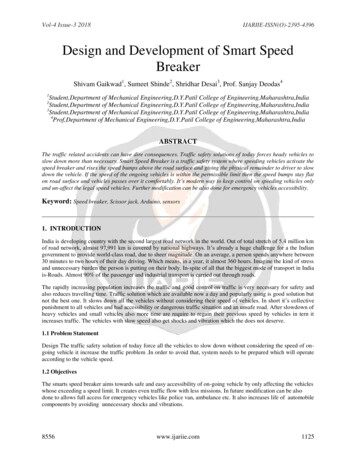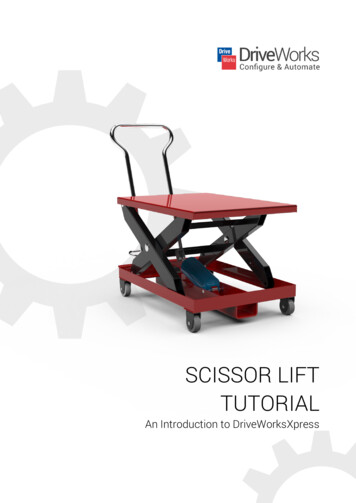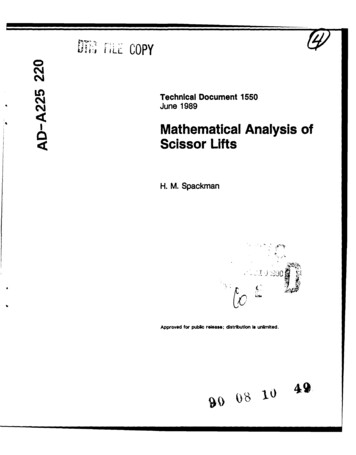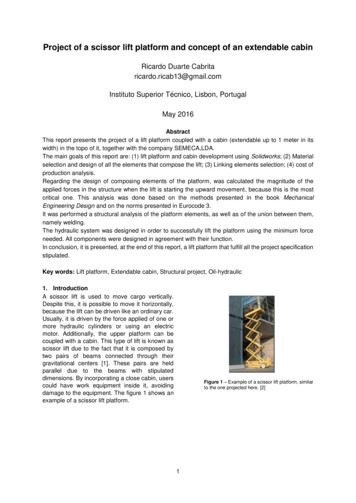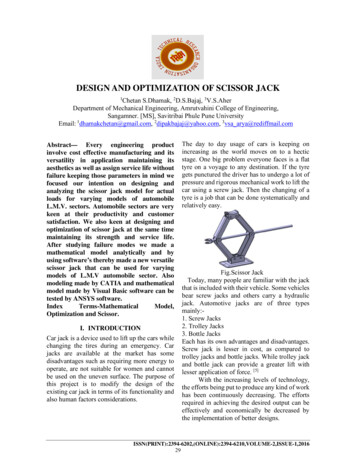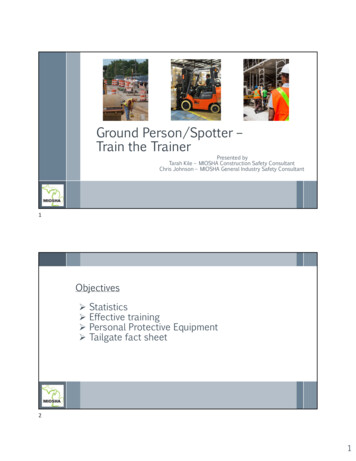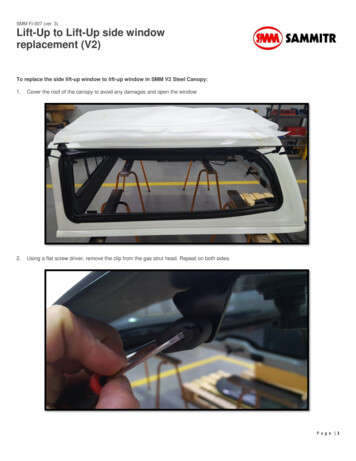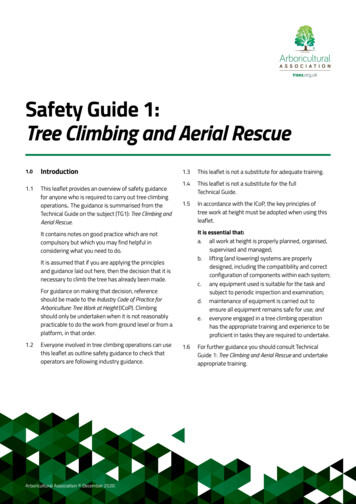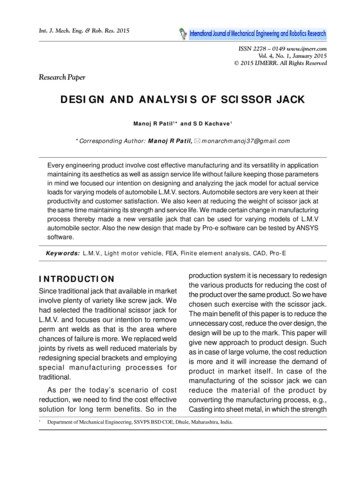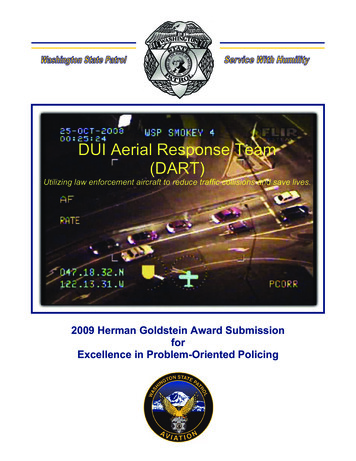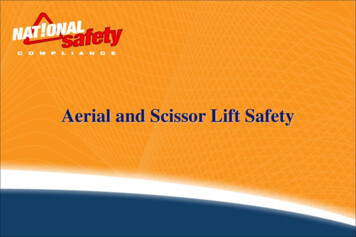
Transcription
Aerial and Scissor Lift Safety
Aerial and Scissor Lift Safety This presentation is intended as a resource for providing trainingon OSHA’s standards regarding aerial lift devices. It is not asubstitute for any of the provisions of the Occupational Safety and Health Act of 1970, or for any standards issued by the U.S. Department of Labor’s Occupational Safety andHealth Administration (OSHA).
Aerial and Scissor Lift Safety Definitions Aerial device - Any vehicle-mounted device, telescoping orarticulating, or both, which is used to position personnel. Aerial lift - Any aerial device used to elevate personnel to jobsites above ground including extensible boomplatforms, aerial ladders, articulating boom platformsand vertical towers. Scissor lift - A mobile supported scaffold which canbe powered or unpowered, is portableand caster or wheel-mounted.
OSHA StandardsOSHA covers the use of aerial lifts inCFR 1926.453 and1926.454. OSHAclassifies scissor lifts as mobilescaffolds and covers them underCFR 1926.451, 1926.452(w) and1926.454. The use of fall protectionis required when using both liftdevices.
Types of Aerial LiftsAerial lifts include the followingtypes of vehicle-mounted aerialdevices used to elevate employeesto job-sites above ground:
Extensible Boom PlatformUses a single arm to lift the platform to thedesired height, often by hydraulics or, lessfrequently, pneumatic pressure. The lengthof the arm limits the reach of the boom lift.Some boom lifts can extend the reach byusing telescoping sections within the arm
Aerial LadderAn aerial device consisting of asingle- or multiple-sectionextensible ladder. Most often usedby Fire Departments.
Articulating Boom PlatformOperates in much the same way as thenormal boom lift, except it consists of atleast one joint in the arm. This joint allowsthe arm to be twice as long.Some are capable of rotating on an axis at thebase or even on the second arm. The second armcan extend horizontally as well as vertically toreach over crowded and difficult areas. This liftprovides great access to difficult areas.
Scissor LiftsScissor lifts are another common type ofaerial working platform. The parts thatelevate the platform contain crossing,interlocking members. When pressure isapplied to the outside of the lowest set ofsupports through hydraulic, pneumatic ormechanical means, the crossing supports'lengthen' to raise the platform.
Scissor LiftsScissor lifts usually cannot reach ashigh as a boom, although some mayreach up to forty or fifty feet high
Training RequirementsOSHA requires training for aerial lifts and scissor lifts according to CFR1926.454. Training should include:
Training RequirementsThe nature of any lift hazards, electrical hazards, fall hazards and falling objecthazards in the work area,The correct procedures for dealing with electrical hazards and for erecting, maintainingand disassembling the fall protection systems and falling object protection systemsbeing used,The correct procedures for moving, operating, repairing, inspecting andmaintaining the type of lift in questionProper use of the lift, and proper handling of materials on the lift,The maximum intended load and the load-carrying capacityof the lift used, andAny additional requirements set bythe manufacturer.
Training RequirementsEmployees must be provided with an operator's manual and amaintenance manual for the lift being used.All operators must demonstrate that theyunderstand how to use the lift and must beretrained if they do not demonstrate theskill or understanding needed forsafe operating procedures.
Training RequirementsEmployees must be retrained when thefollowing situations occur:Changes in the worksite present a hazard which was not previouslyknown to the employees,Changes in the type of lift, fall protection, falling object protectionor other equipment present a hazard which was notpreviously known to the employee, andWhere inadequacies in an affected employee's workinvolving lifts indicate that the employee hasnot retained the requisite proficiency.
Training RequirementsTraining records should be maintained for atleast four years. Required information includes:Names of employees trained, retrained and familiarized,Name of the trainer(s),Training covered,Date of training, andWritten records of all inspectionsand repairs.
Selecting The Right LiftWhen selecting a lift there are some important issues that must be considered.The type of work being performed,The terrain in which the lift will beutilized, andThe number of employees andequipment needed.
InspectionsThere are two main inspections that must be donewhen using an aerial lift device. A pre-startinspection of the lift must be performed beforeeach use and an inspection of the surroundingwork site in which the lift will be utilized.
Pre-Start InspectionThe manufacturer provides a list of items that shouldbe inspected before use in the operator's manual.Some items to inspect include:Operating and Emergency ControlsThe BoomGuardrailsHydraulic SystemOutriggersEmergency Stop ButtonsTiresSafety Guards and SensorsEmergency Descent System
Work Site InspectionIt is necessary to inspect the work site also.Items to inspect include:The surface on which the lift will be used,Hazards that might create dangerous drivingconditions, andWeather conditions.(Additional inspections may berequired by the lift manufacturer.)
Safety ProceduresMost lifts are equipped with various safetyfeatures. Never remove or use these features forany reason other than specified by themanufacturer. Lifts should never be modifiedwithout written permission from themanufacturer or other equivalent entity. Ifmodified, the lift must be at least as safe asbefore it was modified.
Safety ProceduresOnly authorized persons should operate anaerial lift.Belting off to an adjacent pole, structure orequipment while working from a lift isnot permitted.
Safety ProceduresEmployees should alwaysstand firmly on the floor ofthe lift. They should not sitor climb on the basket orguardrails or use planks,ladders or other items toattain a higher workposition.Never attempt this!
Safety ProceduresThe operator should know the total load of the liftincluding tools, supplies and other employees. Theweight of the load should be within the manufacturer'ssuggested maximum safe working load.Make sure the load is balanced.
Safety ProceduresLifts should never be used as a crane unless themanufacture has designed it to lift loads in such amanner.Hard hats should be worn by employees at all times.Before moving the lift all employees should be madeaware of the move.The operator should always refer tothe lift's operator manual for any othersafety procedures specific to the lift.
Specific Safety Procedures for Aerial LiftsBrakes must be set and if the lift has outriggers they mustbe positioned on pads or a solid surface.Wheel chocks must be installed before using an aerial lifton an incline, provided they can be installed safely.An aerial truck should not be moved when theboom is elevated in a working position withmen in the basket unless the lift isspecifically designed forsuch operation.
Specific Safety Procedures for Aerial LiftsAerial work platforms must have both platform and lower controls.Platform controls must be in or beside the platform within easy reachof the operator.Lower controls should be able to overridethe platform controls but should not beused unless permission has been obtainedfrom the employees in the lift or incase of emergency.
Specific Safety Procedures for Aerial LiftsBefore moving an aerial lift for travel, theboom(s) must be properly cradled andoutriggers must be in stowed position.
Specific Safety Procedures for Aerial LiftsIf transferring from the lift platform to an adjacent structure isnecessary, 100% tie off is required. To perform the transfer, twolanyards are required. One must be anchored to the platform andthe other to the structure.The platform must be within one foot of the structure.Another employee on the ground should guide theoperator when transporting the lift from one areato another on the work site. The operator mustmake sure that the boom is never over anemployee that is working on the ground.
Specific Safety Procedures for Scissor LiftsNever raise the platform while the lift is on a truck or other vehicle.Employees should never ride on a scissor lift unless the following conditions exist:The surface on which the lift is being moved is within 3 degrees of level and free of pits,holes and obstructions;The height to base width ratio of the lift during movement is two to one orless unless the lift is designed and manufactured to meet or exceedrecognized stability test requirements such asANSI/SIA A92.5 and A92.6;The lift does not travel more than 1 foot per second; andNo employee is on any part of the lift which extendsoutward beyond the wheels.
Fall ProtectionFall protection is required forall employees that performwork on a lift if they are goingto be elevated to a height of10 feet above a lower level.If the lift is used according to manufacturer'sguidelines and all safety precautionsare being followed, the chanceof any fall is minimal.
Fall ProtectionAll scissor lifts require fall protectionand guardrails that are properlydesigned, maintained and meetOSHA requirements meet thatrequirement. If the guardrail doesnot meet OSHA standards, or if anemployee leaves the safety of thework platform, then a personal fallarrest system utilizing a bodyharness is required.
Fall ProtectionAll aerial lifts require fall protection. Guardrails andbuckets provide some fall protection but due to the“catapulting” characteristics of lifts it is necessary to haveadditional fall protection.A full body harness should be wornand a lanyard attached to the boom orbasket when working from an aerial lift.The length of the lanyard mustconform to the lift manufacturer'sguidelines.
Fall ProtectionMost lifts contain a restraining point which is designed toattach to a personal fall arrest system or restrainingdevice. If no anchor point is available, it is up to the sitesupervisor to determine the best point to tie-off.Tie-off to an adjacent structure isnot allowed due to thepossibility of being pulledout when the lift is moved.
Fall ProtectionYour employer and the manufacturer of the lift in usewill provide more precise fall protection rules andguidelines.Manufacturer's guidelines must always be followed.
Shutdown ProceduresCertain steps must be taken to ensure the safetyof all employees and the lift in use.
QuizClick on the link below to take a 10-Question /powerplatforms.aspxOnce you have linked to the quiz, please enter your Social SecurityNumber at the top. You will need to enter it according to the exampleshown (ex. 999-99-9999 with hyphens included).Once finished with the questions, please click the submit button and yourtraining will be recorded.Note: It takes 90 days for newly hired employees to be loaded to thetraining database. In this case print out the quiz and submit to yoursupervisor or safety training point of contact.
Employees should never ride on a scissor lift unless the following conditions exist: The surface on which the lift is being moved is within 3 degrees of level and free of pits, holes and obstructions; The height to base width ratio of the lift during movement is two to one or less unles
